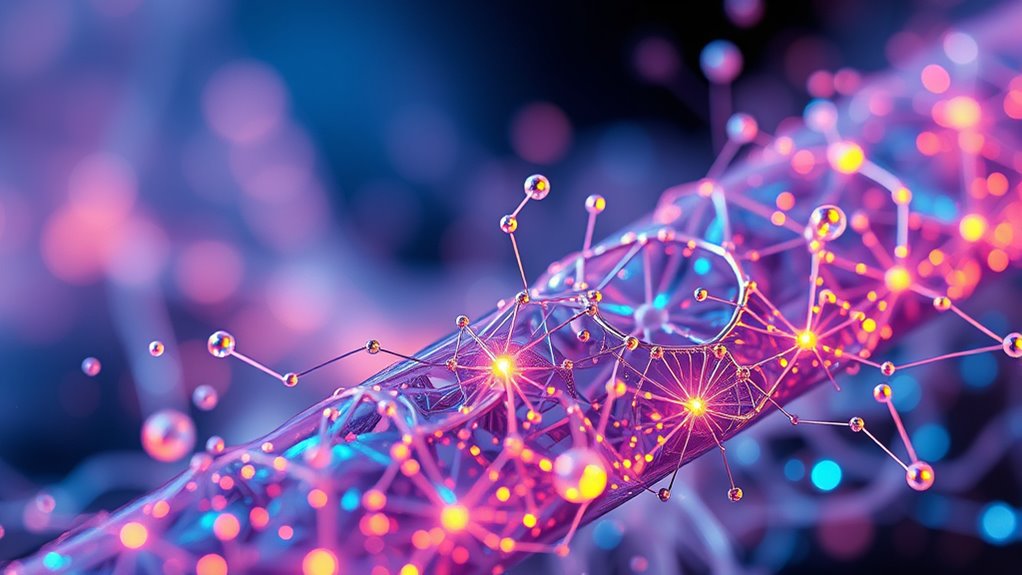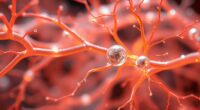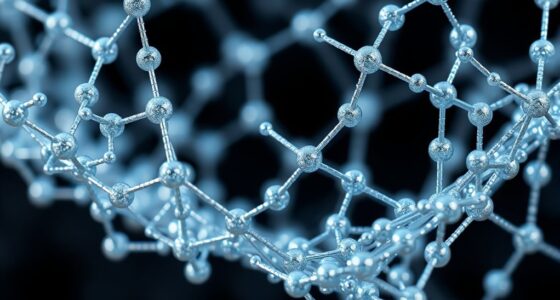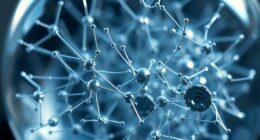Self-healing materials through nanotechnology allow you to create smarter, more durable products. Tiny capsules embedded within the material hold healing agents that are released when damage occurs, quickly repairing cracks and defects. Advances in nano encapsulation and self-repair mechanisms enable these materials to respond automatically, reducing maintenance costs and increasing safety. As researchers continue to develop new techniques, you’ll discover how these innovations can transform industries and improve everyday objects.
Key Takeaways
- Nanotechnology enables precise encapsulation of healing agents for controlled release upon material damage.
- Nano-sized carriers facilitate multi-stage repairs, enhancing durability and resilience of self-healing materials.
- Nano encapsulation techniques trigger chemical reactions that fill and solidify cracks automatically.
- Integration of nanotech improves the longevity and maintenance efficiency of materials across industries.
- Advances in nanomaterials promote autonomous sensing and repair, revolutionizing material performance and safety.
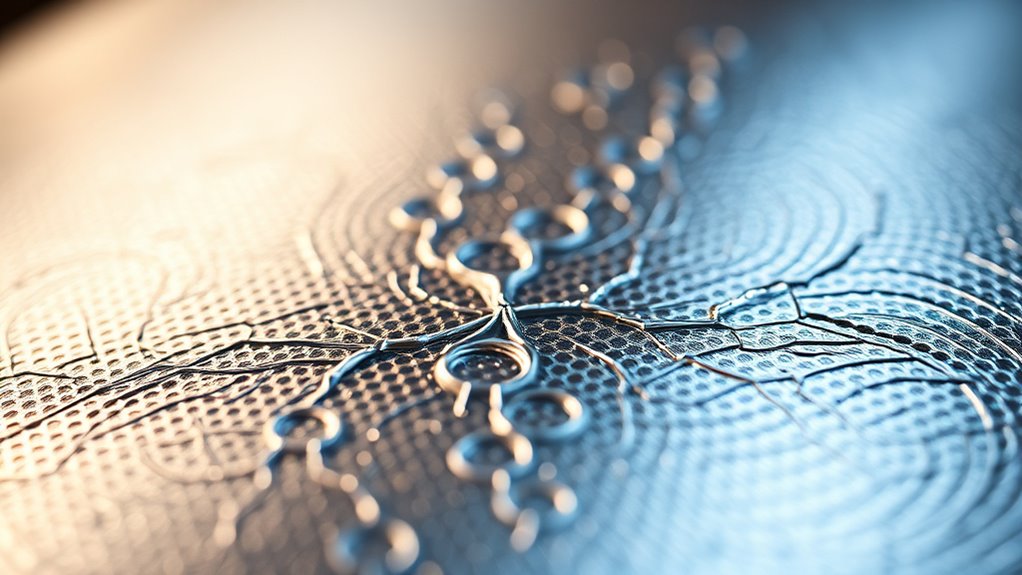
Imagine materials that can repair themselves after damage, extending their lifespan and reducing maintenance costs. This exciting possibility is becoming a reality thanks to advances in nanotechnology, which enables the development of self-healing materials. At the core of these innovations are nano encapsulation techniques and self repair mechanisms that work together to detect and mend cracks or breaks automatically. By embedding tiny capsules filled with healing agents into the material, scientists can create systems that respond instantly when damage occurs. When a crack forms, it ruptures these capsules, releasing the healing substances directly into the affected area. This process triggers a chemical reaction that solidifies and fills the damage, restoring the material’s integrity. The nano encapsulation techniques used here are highly precise, allowing for the controlled release of healing agents only when necessary, which prolongs the material’s durability and optimizes resource use. Furthermore, ongoing research in the field of self-healing materials is expanding the possibilities for even more sophisticated and adaptable repair systems.
Self repair mechanisms in these materials are engineered to mimic natural healing processes. They can be designed to react to various types of damage, whether from mechanical stress, environmental exposure, or chemical attack. These mechanisms often involve polymers or other substances that flow into cracks and harden, sealing the defect seamlessly. Some systems incorporate nano-sized carriers that carry multiple healing agents, enabling multi-stage repairs or repairs that adapt to different types of damage. This layered approach enhances the effectiveness and longevity of the self-healing process, making the materials more resilient over time. The integration of nanotechnology allows for incredibly fine control over the healing process, ensuring that repairs are quick, efficient, and minimally invasive.
As you explore these innovations, you’ll see how self-healing materials could revolutionize industries such as aerospace, automotive, electronics, and infrastructure. They promise to cut down on costly repairs and downtime, all while maintaining safety and performance standards. By harnessing nano encapsulation techniques and advanced self repair mechanisms, researchers are creating smarter, more durable materials that can sense damage and respond autonomously. This synergy of nanotech and materials science paves the way for products that last longer, perform better, and require less intervention. Ultimately, these advancements could lead to a future where maintenance becomes less of a concern, and materials continuously heal themselves, ensuring reliability and safety in countless applications.
Frequently Asked Questions
How Long Do Nanotech-Based Self-Healing Materials Last?
Nanotech-based self-healing materials typically last for several years, depending on usage and environmental conditions. You can expect good material longevity and consistent healing durability if the materials are maintained properly. Factors like stress, temperature, and exposure to elements can affect their lifespan. With proper care, these materials can reliably repair themselves multiple times, ensuring long-term performance and extending their overall durability over time.
Are There Environmental Risks Associated With Nanomaterials?
Coincidentally, environmental impact and toxicity concerns are real when it comes to nanomaterials. You should be aware that some nanomaterials can pose risks to ecosystems and human health if released into the environment. Their small size allows them to penetrate biological systems, raising toxicity concerns. While ongoing research aims to minimize these risks, it’s important to take into account proper handling, disposal, and regulation to reduce potential environmental hazards.
Can These Materials Be Recycled or Reused?
You can often recycle or reuse self-healing nanomaterials, but recycling challenges exist due to their complex structures and integration with other materials. These complexities may make separation difficult, limiting reuse potential. However, researchers are exploring innovative methods to improve recycling processes, aiming to enhance sustainability. While reuse potential is promising, it’s essential to develop efficient techniques to address recycling challenges and maximize the lifespan of these advanced materials.
What Are the Costs of Implementing Nanotechnology in Self-Healing Materials?
The cost implications of implementing nanotechnology in self-healing materials can be significant but are gradually becoming more manageable. While initial investments might seem steep, the potential for enhanced durability and reduced maintenance boosts market viability over time. You might find that as production scales up, costs decrease, making these advanced materials more accessible. Ultimately, balancing innovation with affordability is key to releasing the full benefits of nanotech-enhanced self-healing solutions.
How Do Self-Healing Properties Perform Under Extreme Temperatures?
You’ll find that self-healing materials with nanotechnology maintain impressive thermal stability under extreme temperatures. Their design enhances material resilience, allowing them to repair minor damages even in harsh conditions. However, some nanocomposites may face reduced healing efficiency at very high or low temperatures, so it’s essential to take into account specific material properties. Overall, advances enable you to rely on these materials for durability and sustained performance in demanding environments.
Conclusion
With nanotechnology, self-healing materials become like a living skin, constantly repairing and adapting to damage. You can imagine them as tiny guardians working tirelessly beneath the surface, ensuring durability and longevity. This innovation not only extends the life of materials but also transforms how you approach design and maintenance. As you embrace these advancements, you’ll find that the future feels as resilient as a fortress, built to withstand the tests of time and wear.
